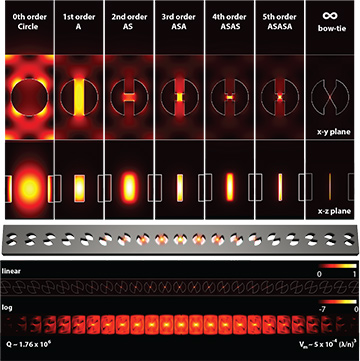 Top: Nanofocusing of light by progressively interlocking anti-slots and slots. Middle: Bowtie photonic crystal cavity design. Bottom: Linear and log plots of mode profile with dielectric structure superimposed.
Top: Nanofocusing of light by progressively interlocking anti-slots and slots. Middle: Bowtie photonic crystal cavity design. Bottom: Linear and log plots of mode profile with dielectric structure superimposed.
Achieving enhanced light–matter interaction is key to advancing technologies related to generating, guiding, modulating and detecting light. Researchers in photonic crystals and plasmonics have taken different approaches to increasing light–matter interaction. Photonic crystals increase temporal confinement of light, as represented by their high quality factor (Q), while plasmonic structures increase spatial confinement, as represented by their low mode volume (Vm). The inability to attain extreme temporal and spatial confinement of light simultaneously, however, remains a barrier to realizing ultimate control of light.
We recently reported a novel method, using a two-step field confinement approach, to achieve both ultra-high Q and ultra-small Vm in a dielectric structure.1 In the first step, light is localized in the air holes of a photonic crystal. In the second step, boundary conditions are imposed to redistribute the light within the air holes by adding subwavelength dielectric features. When a dielectric bar is added, the mode is squeezed into this region due to the discontinuity of the electric displacement field’s tangential component at the air–dielectric interface. We call this energy localization and enhancement the “anti-slot” effect for its complementarity to the slot effect.
Due to the orthogonal nature of electromagnetic boundary conditions, light can be progressively squeezed in both the propagation direction and the perpendicular in-plane direction by introducing a series of interlocked anti-slots and slots, respectively. In the limit, the unit-cell geometry approaches that of a bowtie. The energy density in the center of the bowtie is a remarkable 1,500 times higher than the energy density in the center of a circular unit cell. A photonic crystal cavity designed using a bowtie shaped unit cell possesses an ultra-high Q of 1.76 × 106, with an ultra-small Vm of 5 × 10–4 (λ/n)3. The electric field in the bowtie cavity center is more than 103 times stronger than that in a planar waveguide. This is the highest electromagnetic energy enhancement factor reported to date—at least two orders of magnitude larger than that achieved in a plasmonic bowtie cavity.2
We believe that achieving these metrics constitutes a milestone that could inspire new photonic-device designs supporting record performance across a range of optical applications. For example, a study subsequent to ours has suggested that dielectric bowtie cavities could support ultra-strong nonlinearities, approaching the single-photon level.3 Experimental realization of bowtie photonic crystals also has recently been reported.4
Researchers
S. Hu and S.M. Weiss, Vanderbilt University, Nashville, Tenn., USA
References
1. S. Hu and S.M. Weiss. ACS Photonics 3, 1647 (2016).
2. J. A. Schuller et al. Nat. Mater. 9, 193 (2010).
3. H. Choi et al. Phys. Rev. Lett. 118, 223605 (2017).
4. S. Hu et al. arXiv:1707.04672 (2017).
